
Zhang Hui, a staff member of the Yungang Grottoes Research Institute, restores an iron ware at a studio of the institute in Datong, north China's Shanxi Province, Feb. 26, 2024. Yungang Grottoes, a UNESCO World Heritage site featuring over 50,000 stone Buddhist sculptures in Datong, was built during the Northern Wei Dynasty (386-534). It is considered a pinnacle of Chinese Buddhist art and represents the highest level of sculptural artistry in the world during the 5th century.
The Yungang Grottoes Research Institute boasts a relics protection and restoration team mainly consisting of professionals in their 20s and 30s, who are trying their very best to keep these statues in their prime condition as long as possible.
Dubbed doctors for relics, these young souls armed with modern technologies have gone beyond fundamental protection and restoration, and walked the extra mile to present these statues in a much more vivid way before tourists and learners from all over the world. (Xinhua/Zhan Yan)

Jia Ning (L), a staff member of the Yungang Grottoes Research Institute, restores a mural with his colleague at a studio of the institute in Datong, north China's Shanxi Province, Feb. 26, 2024. Yungang Grottoes, a UNESCO World Heritage site featuring over 50,000 stone Buddhist sculptures in Datong, was built during the Northern Wei Dynasty (386-534). It is considered a pinnacle of Chinese Buddhist art and represents the highest level of sculptural artistry in the world during the 5th century.
The Yungang Grottoes Research Institute boasts a relics protection and restoration team mainly consisting of professionals in their 20s and 30s, who are trying their very best to keep these statues in their prime condition as long as possible.
Dubbed doctors for relics, these young souls armed with modern technologies have gone beyond fundamental protection and restoration, and walked the extra mile to present these statues in a much more vivid way before tourists and learners from all over the world. (Xinhua/Zhan Yan)
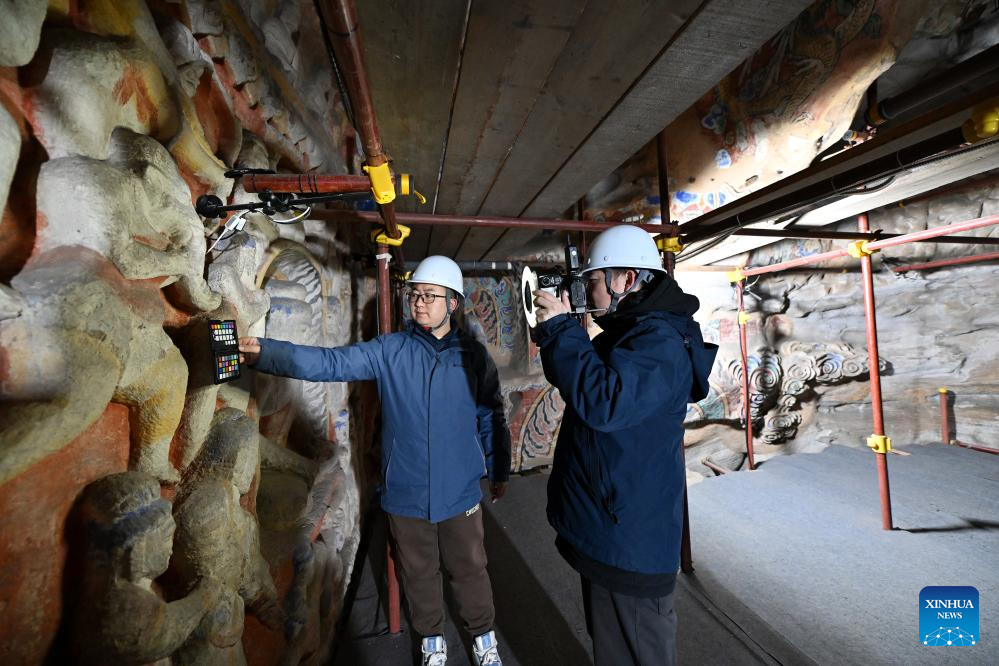
Li Min (R), a staff member of the Yungang Grottoes Research Institute, captures images with his colleague Pan Peng at one of the Yungang Grottoes in Datong, north China's Shanxi Province, Feb. 27, 2024. Yungang Grottoes, a UNESCO World Heritage site featuring over 50,000 stone Buddhist sculptures in Datong, was built during the Northern Wei Dynasty (386-534). It is considered a pinnacle of Chinese Buddhist art and represents the highest level of sculptural artistry in the world during the 5th century.
The Yungang Grottoes Research Institute boasts a relics protection and restoration team mainly consisting of professionals in their 20s and 30s, who are trying their very best to keep these statues in their prime condition as long as possible.
Dubbed doctors for relics, these young souls armed with modern technologies have gone beyond fundamental protection and restoration, and walked the extra mile to present these statues in a much more vivid way before tourists and learners from all over the world. (Xinhua/Zhan Yan)
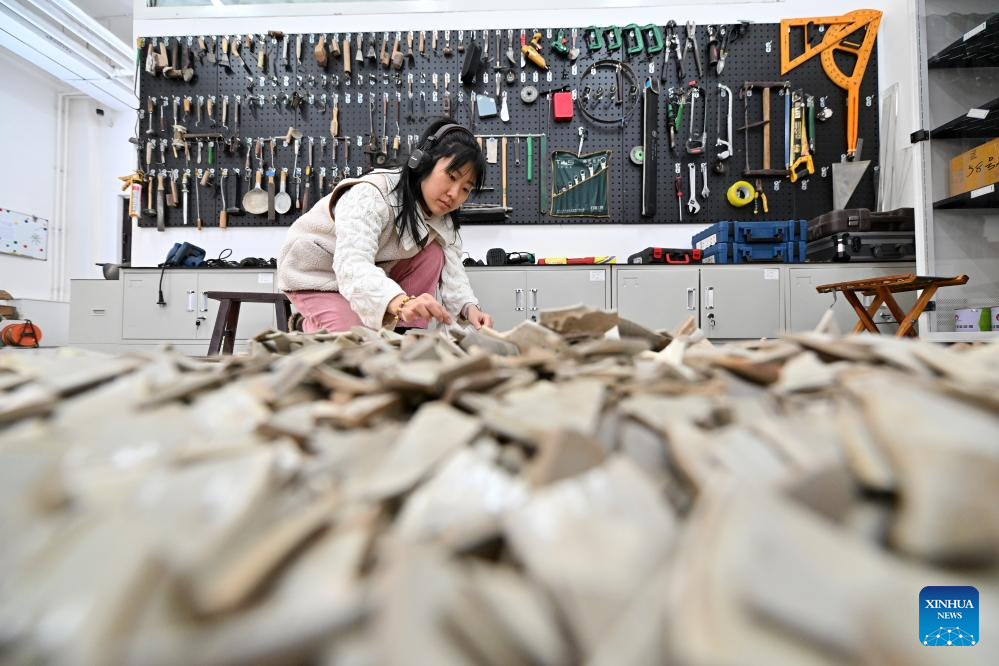
Gao Jiaheng, a staff member of the Yungang Grottoes Research Institute, restores a porcelain ware at a studio of the institute in Datong, north China's Shanxi Province, Feb. 26, 2024. Yungang Grottoes, a UNESCO World Heritage site featuring over 50,000 stone Buddhist sculptures in Datong, was built during the Northern Wei Dynasty (386-534). It is considered a pinnacle of Chinese Buddhist art and represents the highest level of sculptural artistry in the world during the 5th century.
The Yungang Grottoes Research Institute boasts a relics protection and restoration team mainly consisting of professionals in their 20s and 30s, who are trying their very best to keep these statues in their prime condition as long as possible.
Dubbed doctors for relics, these young souls armed with modern technologies have gone beyond fundamental protection and restoration, and walked the extra mile to present these statues in a much more vivid way before tourists and learners from all over the world. (Xinhua/Zhan Yan)
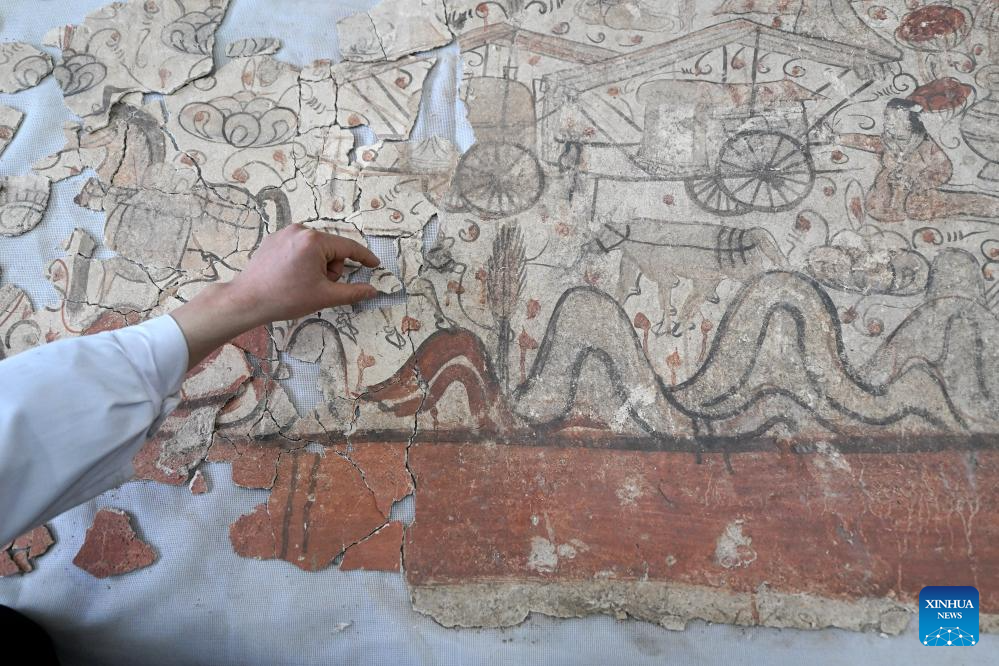
Dai Yuxiang, a staff member of the Yungang Grottoes Research Institute, restores a mural at a studio of the institute in Datong, north China's Shanxi Province, Feb. 27, 2024. Yungang Grottoes, a UNESCO World Heritage site featuring over 50,000 stone Buddhist sculptures in Datong, was built during the Northern Wei Dynasty (386-534). It is considered a pinnacle of Chinese Buddhist art and represents the highest level of sculptural artistry in the world during the 5th century.
The Yungang Grottoes Research Institute boasts a relics protection and restoration team mainly consisting of professionals in their 20s and 30s, who are trying their very best to keep these statues in their prime condition as long as possible.
Dubbed doctors for relics, these young souls armed with modern technologies have gone beyond fundamental protection and restoration, and walked the extra mile to present these statues in a much more vivid way before tourists and learners from all over the world. (Xinhua/Zhan Yan)
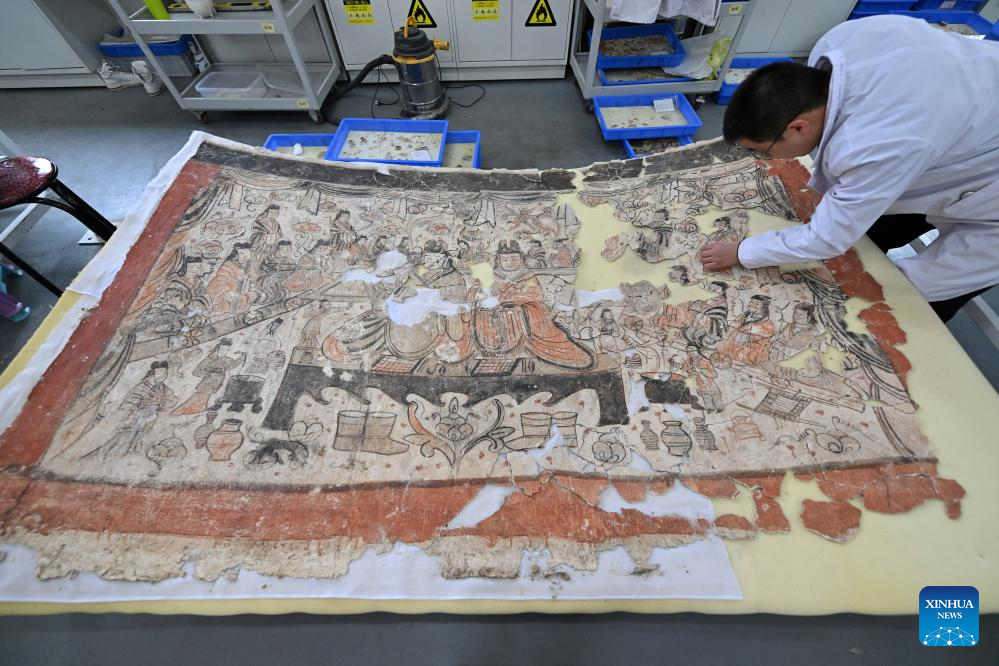
Wang Jianguo, a staff member of the Yungang Grottoes Research Institute, restores a mural at a studio of the institute in Datong, north China's Shanxi Province, Feb. 27, 2024. Yungang Grottoes, a UNESCO World Heritage site featuring over 50,000 stone Buddhist sculptures in Datong, was built during the Northern Wei Dynasty (386-534). It is considered a pinnacle of Chinese Buddhist art and represents the highest level of sculptural artistry in the world during the 5th century.
The Yungang Grottoes Research Institute boasts a relics protection and restoration team mainly consisting of professionals in their 20s and 30s, who are trying their very best to keep these statues in their prime condition as long as possible.
Dubbed doctors for relics, these young souls armed with modern technologies have gone beyond fundamental protection and restoration, and walked the extra mile to present these statues in a much more vivid way before tourists and learners from all over the world. (Xinhua/Zhan Yan)
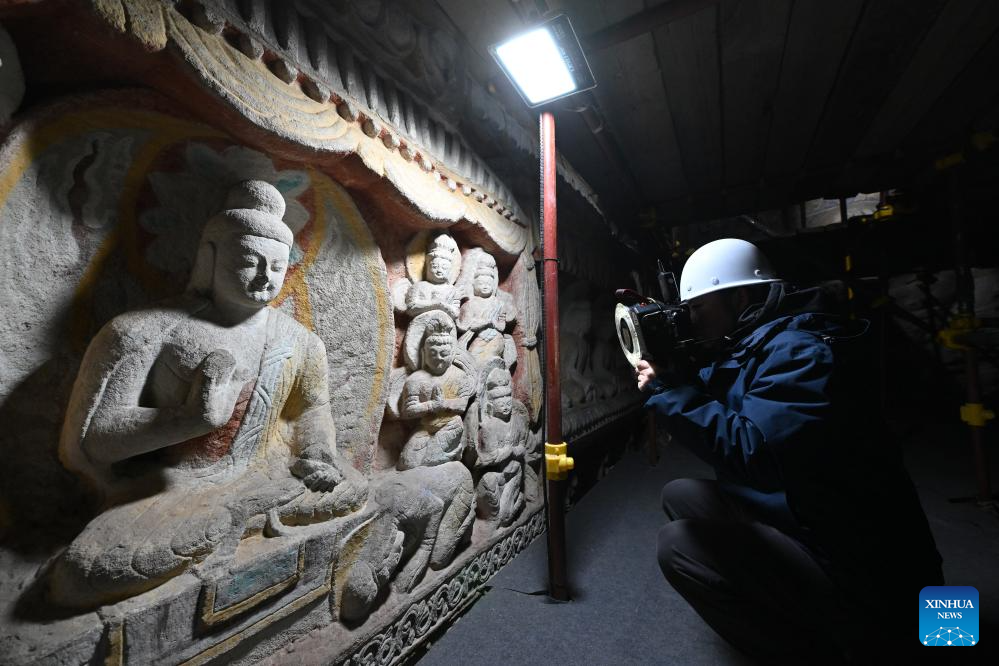
Li Min, a staff member of the Yungang Grottoes Research Institute, captures images at one of the Yungang Grottoes in Datong, north China's Shanxi Province, Feb. 27, 2024. Yungang Grottoes, a UNESCO World Heritage site featuring over 50,000 stone Buddhist sculptures in Datong, was built during the Northern Wei Dynasty (386-534). It is considered a pinnacle of Chinese Buddhist art and represents the highest level of sculptural artistry in the world during the 5th century.
The Yungang Grottoes Research Institute boasts a relics protection and restoration team mainly consisting of professionals in their 20s and 30s, who are trying their very best to keep these statues in their prime condition as long as possible.
Dubbed doctors for relics, these young souls armed with modern technologies have gone beyond fundamental protection and restoration, and walked the extra mile to present these statues in a much more vivid way before tourists and learners from all over the world. (Xinhua/Zhan Yan)
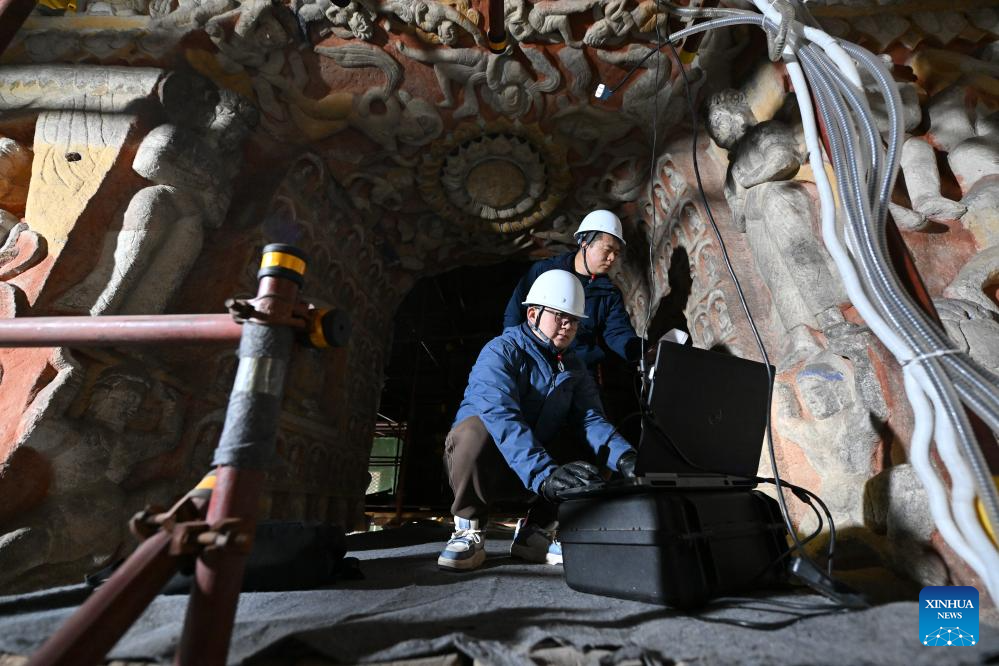
Pan Peng (front), a staff member of the Yungang Grottoes Research Institute, collects data with his colleague Du Qiang at one of the Yungang Grottoes in Datong, north China's Shanxi Province, Feb. 27, 2024. Yungang Grottoes, a UNESCO World Heritage site featuring over 50,000 stone Buddhist sculptures in Datong, was built during the Northern Wei Dynasty (386-534). It is considered a pinnacle of Chinese Buddhist art and represents the highest level of sculptural artistry in the world during the 5th century.
The Yungang Grottoes Research Institute boasts a relics protection and restoration team mainly consisting of professionals in their 20s and 30s, who are trying their very best to keep these statues in their prime condition as long as possible.
Dubbed doctors for relics, these young souls armed with modern technologies have gone beyond fundamental protection and restoration, and walked the extra mile to present these statues in a much more vivid way before tourists and learners from all over the world. (Xinhua/Zhan Yan)
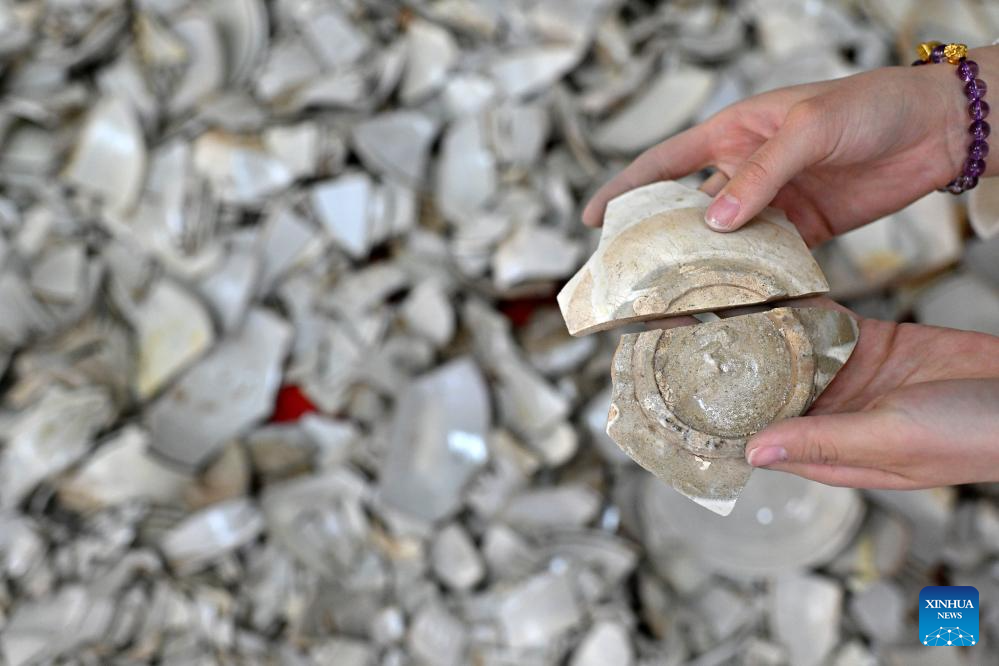
Gao Jiaheng, a staff member of the Yungang Grottoes Research Institute, restores a broken porcelain item at a studio of the institute in Datong, north China's Shanxi Province, Feb. 26, 2024. Yungang Grottoes, a UNESCO World Heritage site featuring over 50,000 stone Buddhist sculptures in Datong, was built during the Northern Wei Dynasty (386-534). It is considered a pinnacle of Chinese Buddhist art and represents the highest level of sculptural artistry in the world during the 5th century.
The Yungang Grottoes Research Institute boasts a relics protection and restoration team mainly consisting of professionals in their 20s and 30s, who are trying their very best to keep these statues in their prime condition as long as possible.
Dubbed doctors for relics, these young souls armed with modern technologies have gone beyond fundamental protection and restoration, and walked the extra mile to present these statues in a much more vivid way before tourists and learners from all over the world. (Xinhua/Zhan Yan)
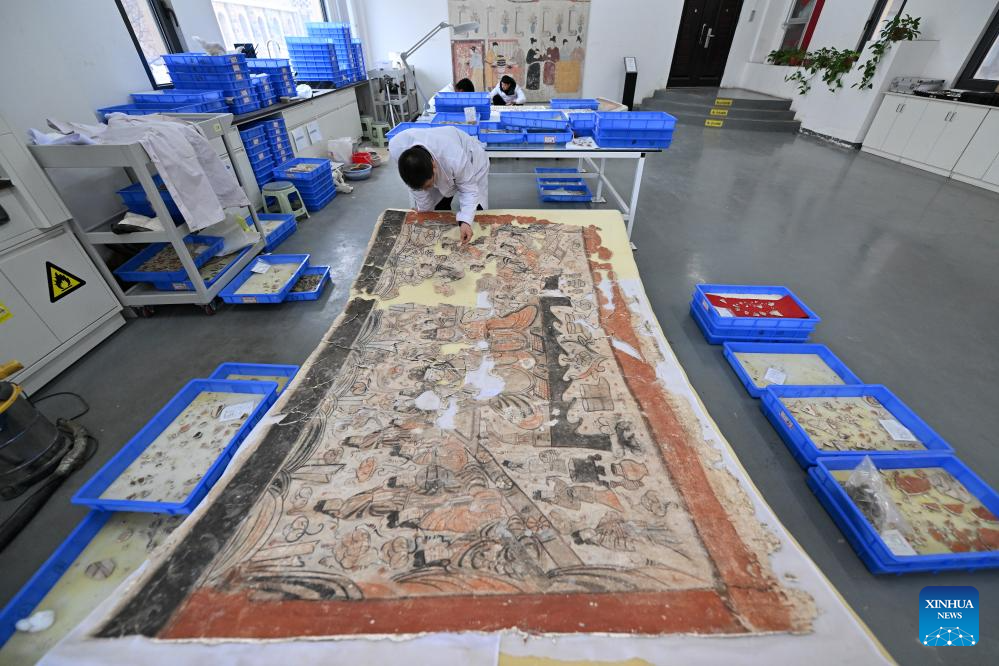
Wang Jianguo (front), a staff member of the Yungang Grottoes Research Institute, restores a mural with his colleagues at a studio of the institute in Datong, north China's Shanxi Province, Feb. 27, 2024. Yungang Grottoes, a UNESCO World Heritage site featuring over 50,000 stone Buddhist sculptures in Datong, was built during the Northern Wei Dynasty (386-534). It is considered a pinnacle of Chinese Buddhist art and represents the highest level of sculptural artistry in the world during the 5th century.
The Yungang Grottoes Research Institute boasts a relics protection and restoration team mainly consisting of professionals in their 20s and 30s, who are trying their very best to keep these statues in their prime condition as long as possible.
Dubbed doctors for relics, these young souls armed with modern technologies have gone beyond fundamental protection and restoration, and walked the extra mile to present these statues in a much more vivid way before tourists and learners from all over the world. (Xinhua/Zhan Yan)

Feng Jun, a staff member of the Yungang Grottoes Research Institute, restores a mural at a studio of the institute in Datong, north China's Shanxi Province, Feb. 26, 2024. Yungang Grottoes, a UNESCO World Heritage site featuring over 50,000 stone Buddhist sculptures in Datong, was built during the Northern Wei Dynasty (386-534). It is considered a pinnacle of Chinese Buddhist art and represents the highest level of sculptural artistry in the world during the 5th century.
The Yungang Grottoes Research Institute boasts a relics protection and restoration team mainly consisting of professionals in their 20s and 30s, who are trying their very best to keep these statues in their prime condition as long as possible.
Dubbed doctors for relics, these young souls armed with modern technologies have gone beyond fundamental protection and restoration, and walked the extra mile to present these statues in a much more vivid way before tourists and learners from all over the world. (Xinhua/Zhan Yan)
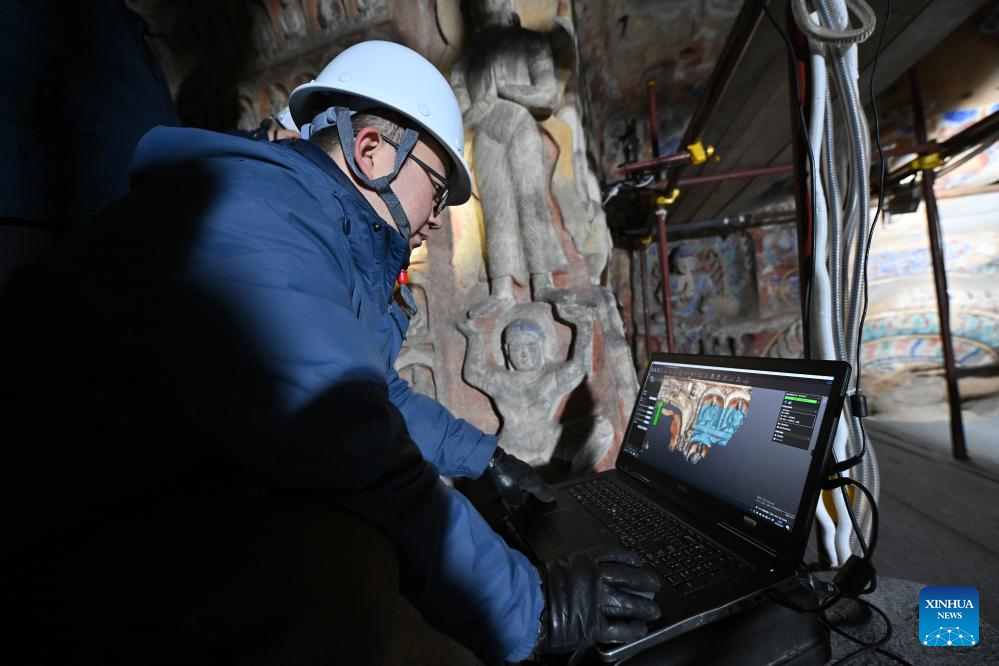
Pan Peng, a staff member of the Yungang Grottoes Research Institute, collects data at one of the Yungang Grottoes in Datong, north China's Shanxi Province, Feb. 27, 2024. Yungang Grottoes, a UNESCO World Heritage site featuring over 50,000 stone Buddhist sculptures in Datong, was built during the Northern Wei Dynasty (386-534). It is considered a pinnacle of Chinese Buddhist art and represents the highest level of sculptural artistry in the world during the 5th century.
The Yungang Grottoes Research Institute boasts a relics protection and restoration team mainly consisting of professionals in their 20s and 30s, who are trying their very best to keep these statues in their prime condition as long as possible.
Dubbed doctors for relics, these young souls armed with modern technologies have gone beyond fundamental protection and restoration, and walked the extra mile to present these statues in a much more vivid way before tourists and learners from all over the world. (Xinhua/Zhan Yan)
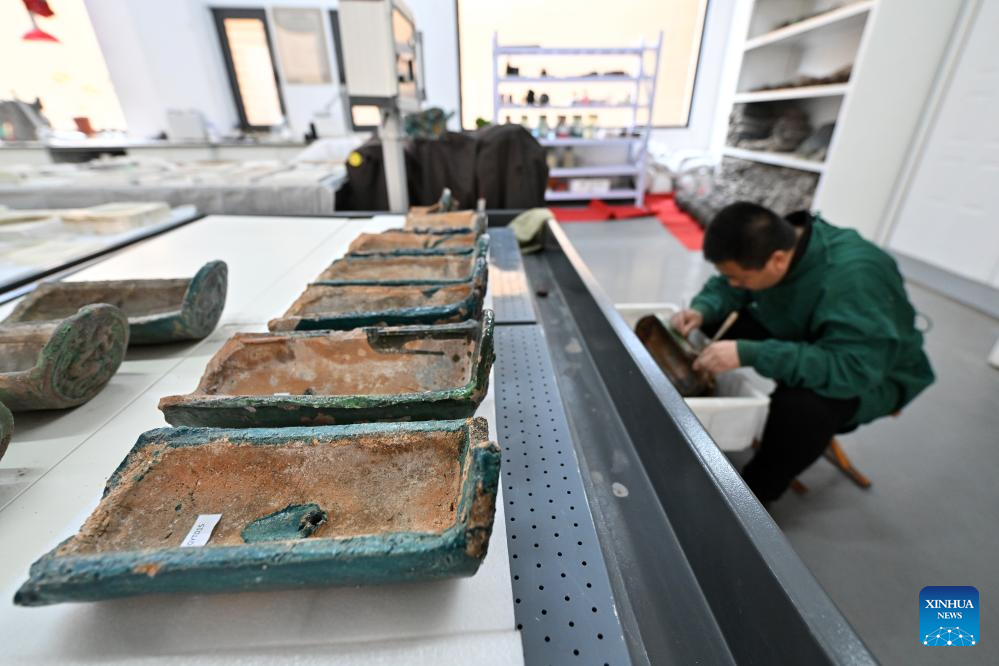
Wei Songlin, a staff member of the Yungang Grottoes Research Institute, restores a glazed tile at a studio of the institute in Datong, north China's Shanxi Province, Feb. 26, 2024. Yungang Grottoes, a UNESCO World Heritage site featuring over 50,000 stone Buddhist sculptures in Datong, was built during the Northern Wei Dynasty (386-534). It is considered a pinnacle of Chinese Buddhist art and represents the highest level of sculptural artistry in the world during the 5th century.
The Yungang Grottoes Research Institute boasts a relics protection and restoration team mainly consisting of professionals in their 20s and 30s, who are trying their very best to keep these statues in their prime condition as long as possible.
Dubbed doctors for relics, these young souls armed with modern technologies have gone beyond fundamental protection and restoration, and walked the extra mile to present these statues in a much more vivid way before tourists and learners from all over the world. (Xinhua/Zhan Yan)

Han Yuehua, a staff member of the Yungang Grottoes Research Institute, removes dust from a relic item at a studio of the institute in Datong, north China's Shanxi Province, Feb. 26, 2024. Yungang Grottoes, a UNESCO World Heritage site featuring over 50,000 stone Buddhist sculptures in Datong, was built during the Northern Wei Dynasty (386-534). It is considered a pinnacle of Chinese Buddhist art and represents the highest level of sculptural artistry in the world during the 5th century.
The Yungang Grottoes Research Institute boasts a relics protection and restoration team mainly consisting of professionals in their 20s and 30s, who are trying their very best to keep these statues in their prime condition as long as possible.
Dubbed doctors for relics, these young souls armed with modern technologies have gone beyond fundamental protection and restoration, and walked the extra mile to present these statues in a much more vivid way before tourists and learners from all over the world. (Xinhua/Zhan Yan)
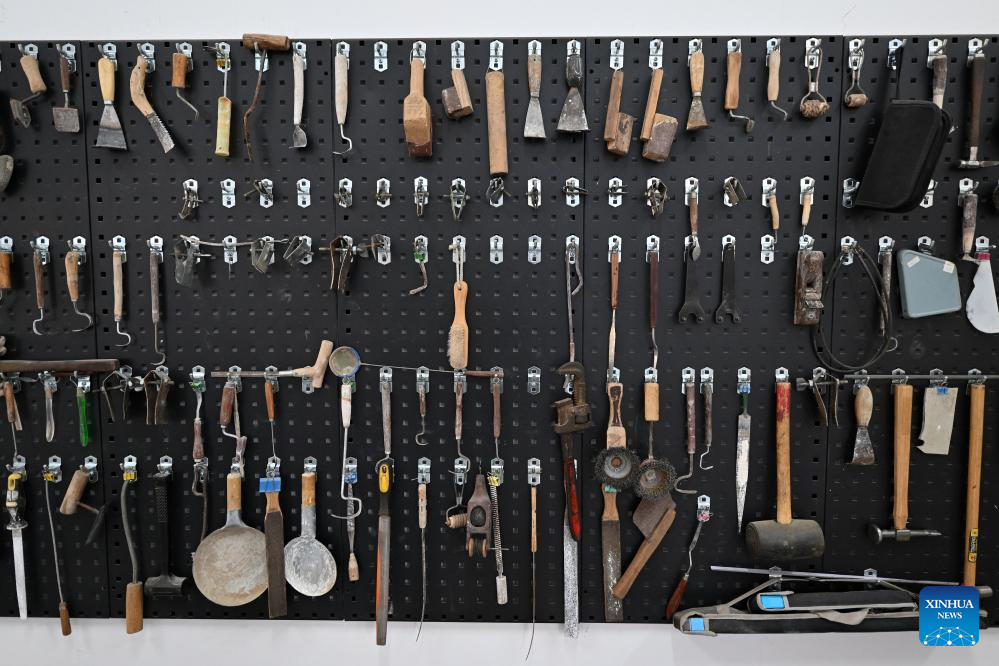
Restoration tools are seen displayed on the wall of a studio at the Yungang Grottoes Research Institute in Datong, north China's Shanxi Province, Feb. 26, 2024. Yungang Grottoes, a UNESCO World Heritage site featuring over 50,000 stone Buddhist sculptures in Datong, was built during the Northern Wei Dynasty (386-534). It is considered a pinnacle of Chinese Buddhist art and represents the highest level of sculptural artistry in the world during the 5th century.
The Yungang Grottoes Research Institute boasts a relics protection and restoration team mainly consisting of professionals in their 20s and 30s, who are trying their very best to keep these statues in their prime condition as long as possible.
Dubbed doctors for relics, these young souls armed with modern technologies have gone beyond fundamental protection and restoration, and walked the extra mile to present these statues in a much more vivid way before tourists and learners from all over the world. (Xinhua/Zhan Yan)
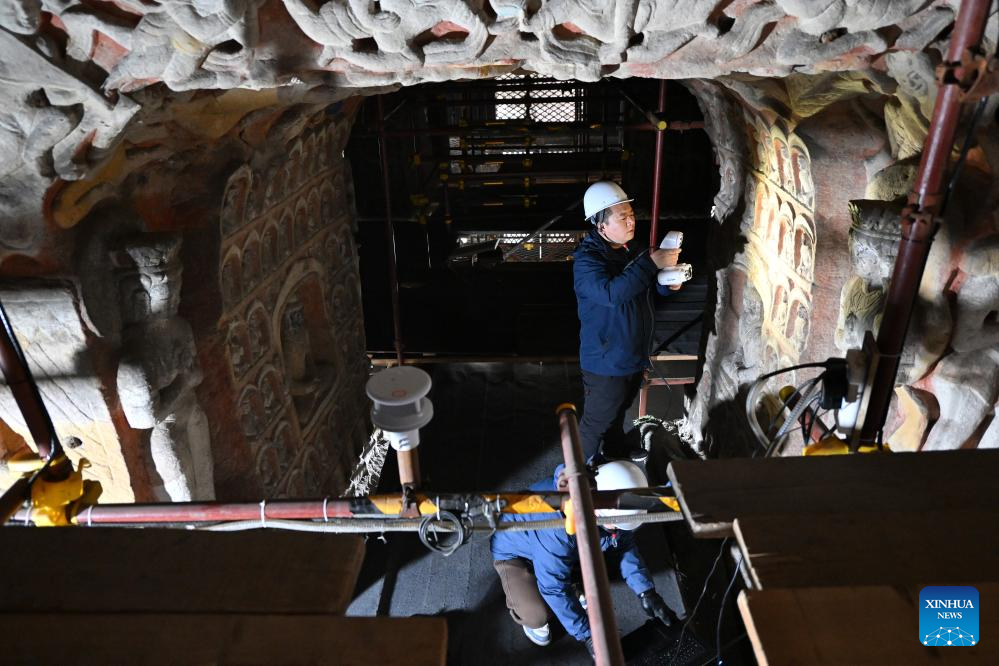
Du Qiang (back), a staff member of the Yungang Grottoes Research Institute, collects data with his colleague Pan Peng at one of the Yungang Grottoes in Datong, north China's Shanxi Province, Feb. 27, 2024. Yungang Grottoes, a UNESCO World Heritage site featuring over 50,000 stone Buddhist sculptures in Datong, was built during the Northern Wei Dynasty (386-534). It is considered a pinnacle of Chinese Buddhist art and represents the highest level of sculptural artistry in the world during the 5th century.
The Yungang Grottoes Research Institute boasts a relics protection and restoration team mainly consisting of professionals in their 20s and 30s, who are trying their very best to keep these statues in their prime condition as long as possible.
Dubbed doctors for relics, these young souls armed with modern technologies have gone beyond fundamental protection and restoration, and walked the extra mile to present these statues in a much more vivid way before tourists and learners from all over the world. (Xinhua/Zhan Yan)



